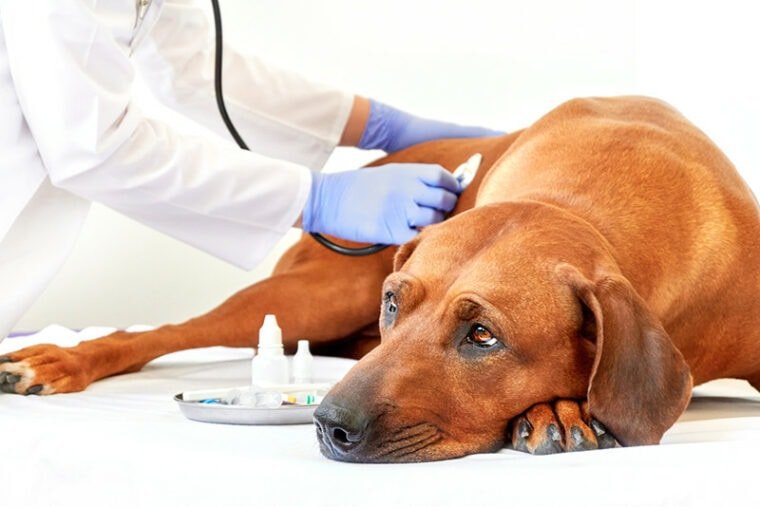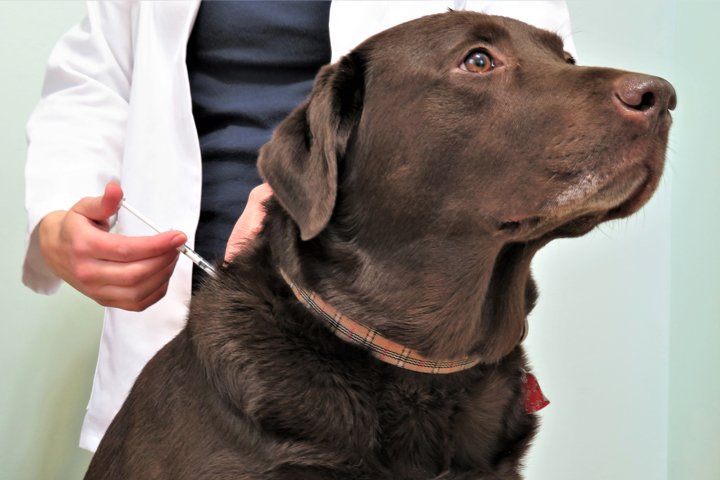How To Treat Your Diabetic Dog At Home
Managing diabetes in dogs typically involves a combination of at-home care and veterinary guidance. While it’s important to work closely with your veterinarian, there are several aspects of home care that can help in treating your dog’s diabetes:
- Regular Monitoring: Keep a close eye on your dog’s blood glucose levels. Your veterinarian will teach you how to use a glucose meter to check blood sugar levels at home. Monitoring helps you and your vet adjust the treatment plan as needed.
- Insulin Administration: Administer insulin as prescribed by your veterinarian. You’ll need to give insulin injections to your dog at specific times each day. Make sure you’re comfortable with the injection technique and maintain a consistent schedule.
- Proper Diet: Follow your vet’s dietary recommendations. A balanced and consistent diet is crucial for managing diabetes. Feeding your dog at the same times each day helps regulate blood sugar. High-fiber diets may be recommended for some dogs.
- Weight Management: Help your dog maintain a healthy weight. Overweight dogs are at a higher risk of developing diabetes, and weight loss can sometimes improve insulin sensitivity.
- Regular Exercise: Encourage regular exercise within the limits set by your veterinarian. Exercise helps improve insulin sensitivity and can aid in regulating blood sugar levels.
- Stress Reduction: Minimize stress in your dog’s environment. Stress can affect blood sugar levels. Keep routines as consistent as possible.
- Closely Monitor for Signs: Keep an eye out for signs of hypoglycemia (low blood sugar) or hyperglycemia (high blood sugar). Symptoms may include weakness, shivering, seizures, or changes in appetite. Follow your vet’s guidance on how to manage these situations.
- Frequent Vet Checkups: Regular veterinary checkups are essential to monitor your dog’s progress and make any necessary adjustments to the treatment plan.
- Education: Learn as much as you can about canine diabetes. Understanding the condition and its management is crucial for providing the best care for your dog.
- Compliance: Consistency is key. Stick to the prescribed treatment plan, including insulin injections, feeding schedule, and exercise routine. Any changes or deviations should be discussed with your vet.
It’s important to note that diabetes management in dogs can be complex, and individual dogs may have different needs and responses to treatment. Always follow your veterinarian’s guidance and maintain open communication with them. They will help tailor the treatment plan to your dog’s specific condition and provide support and guidance along the way.
Can a dog with diabetes be cured at home?
Diabetes in dogs is a chronic condition that typically requires ongoing management rather than a cure. While there is no cure for diabetes in dogs, the condition can be effectively managed with proper veterinary care, including insulin therapy, diet management, and regular monitoring.
It’s essential to work closely with a veterinarian to develop and implement a comprehensive treatment plan for a dog with diabetes. Attempting to manage or cure diabetes at home without professional guidance can lead to serious health complications for the dog.
Key components of managing diabetes in dogs include:
- Insulin Therapy:
- Dogs with diabetes often require insulin injections to help regulate blood sugar levels. The type of insulin, dosage, and administration schedule are determined by the veterinarian based on the individual dog’s needs.
- Diet Management:
- A carefully controlled and consistent diet is crucial for managing diabetes. Specialized prescription diets or homemade diets may be recommended, and feeding times should be consistent.
- Regular Monitoring:
- Monitoring blood glucose levels is an integral part of managing diabetes. Regular veterinary check-ups and, in some cases, at-home monitoring of blood glucose levels help ensure proper adjustment of the treatment plan.
- Exercise:
- Regular, moderate exercise is beneficial for dogs with diabetes. Exercise can help regulate blood sugar levels and contribute to overall health. However, the exercise routine should be consistent and coordinated with the veterinarian’s recommendations.
- Weight Management:
- Maintaining a healthy weight is important for diabetic dogs. Obesity can contribute to insulin resistance, while being underweight may require adjustments to the insulin dosage.
It’s crucial to follow the veterinarian’s recommendations, administer insulin as prescribed, and attend regular check-ups to assess the dog’s response to treatment. Home management of diabetes involves a commitment to consistent care, including proper nutrition, insulin administration, and regular veterinary follow-ups.
If you suspect that your dog may have diabetes or if you have concerns about its health, it’s essential to seek prompt veterinary attention. Early diagnosis and effective management can significantly improve the quality of life for dogs with diabetes.
Home remedies to treat diabetic dogs at home
While there is no substitute for professional veterinary care in managing diabetes in dogs, there are certain supportive measures and lifestyle adjustments that can be incorporated at home to complement the veterinarian’s treatment plan. However, it’s crucial to consult with a veterinarian before implementing any changes to ensure they are appropriate for your dog’s specific condition. Here are some general home care considerations for diabetic dogs:
- Diet:
- Feed a consistent and balanced diet at regular intervals. Prescription diabetic dog foods or homemade diets recommended by the veterinarian may be used. Avoid feeding high-carbohydrate and sugary foods.
- Portion Control:
- Monitor and control the portion sizes to help regulate blood sugar levels. Consistent feeding times and portion control are crucial components of diabetes management.
- Low-Glycemic Foods:
- Consider incorporating low-glycemic foods into the dog’s diet. These foods have a slower impact on blood sugar levels. Your veterinarian can provide guidance on suitable options.
- Regular Exercise:
- Maintain a regular and moderate exercise routine for your dog. Exercise helps regulate blood sugar levels and contributes to overall well-being. However, it’s important to coordinate the exercise plan with the veterinarian to ensure it aligns with the dog’s health status.
- Monitoring:
- Follow the veterinarian’s recommendations for monitoring blood glucose levels at home if applicable. Some diabetic dogs may require at-home monitoring, and the veterinarian can guide you on the process.
- Weight Management:
- Maintain a healthy weight for your dog. Obesity can contribute to insulin resistance, while being underweight may necessitate adjustments to the insulin dosage.
- Consistent Routine:
- Establish a consistent daily routine for feeding, insulin administration, and exercise. Dogs often thrive on routine, and consistency helps in managing their diabetes effectively.
- Regular Veterinary Check-ups:
- Schedule regular check-ups with the veterinarian to assess your dog’s overall health and adjust the treatment plan as needed. Early detection of any changes in the dog’s condition is crucial.
It’s important to note that these measures are supportive and should not replace professional veterinary care. The primary treatment for diabetes in dogs involves insulin therapy and close monitoring by a veterinarian. Home care measures should be discussed and approved by the veterinarian to ensure they are appropriate for your dog’s specific needs. Always seek veterinary advice if you have concerns or questions about your diabetic dog’s care.
What food is best for a diabetic dog?
For diabetic dogs, a balanced and consistent diet is crucial to help manage blood sugar levels. Here are some general guidelines for choosing the best food for a diabetic dog:
- High-Quality Protein: Choose dog foods with high-quality proteins, such as lean meats (chicken, turkey, beef) or fish. Protein can help maintain muscle mass and regulate blood sugar levels.
- Low Carbohydrates: Opt for dog foods with lower carbohydrate content. Carbohydrates can significantly impact blood sugar levels, so choose complex carbohydrates with a low glycemic index.
- Fiber: Fiber is beneficial for dogs with diabetes as it can help regulate blood sugar levels. Look for dog foods that contain moderate to high levels of fiber, but avoid excessive amounts.
- Limited Fat: While dogs need some fat in their diet, it’s important to limit fat intake, especially if the dog is overweight. Obesity can contribute to insulin resistance.
- Consistent Feeding Schedule: Establish a regular feeding schedule for your diabetic dog. Consistency in the timing and amount of food can help with insulin management.
- Prescription Diabetic Dog Food: Some veterinary diets are specifically formulated for diabetic dogs. These diets may have controlled levels of carbohydrates and other nutrients to support diabetic management. Consult with your vet to see if a prescription diet is appropriate for your dog.
Remember, individual dogs may have different dietary requirements, and your veterinarian is the best person to provide guidance on your diabetic dog’s specific needs. Regular monitoring of your dog’s blood sugar levels and adjustments to the diet may be necessary based on your veterinarian’s recommendations.
Can you feed rice to a diabetic dog?
Feeding rice to a diabetic dog should be done cautiously and in moderation. While rice is a source of carbohydrates, which can impact blood sugar levels, it is also a good source of energy and can be part of a balanced diet if managed properly.
Here are some considerations when feeding rice to a diabetic dog:
- Choose Brown Rice: Brown rice is a whole grain and contains more fiber than white rice. The fiber content can help slow down the absorption of sugar, potentially leading to more stable blood sugar levels. However, it’s essential to monitor the overall carbohydrate intake.
- Control Portion Sizes: Pay attention to portion sizes when including rice in your dog’s diet. Controlling the amount of rice can help manage the impact on blood sugar levels.
- Balance with Protein: When feeding rice to a diabetic dog, ensure that it is part of a balanced meal that includes high-quality proteins. Protein can help regulate blood sugar levels and provide essential nutrients.
- Regular Monitoring: Regular monitoring of your diabetic dog’s blood sugar levels is crucial. If you notice any fluctuations, you may need to adjust the diet in consultation with your veterinarian.
- Consult Your Veterinarian: Always consult with your veterinarian before making significant changes to your diabetic dog’s diet. They can provide specific recommendations based on your dog’s individual needs and health status.
It’s important to note that every dog is unique, and what works for one may not work for another. Your veterinarian can provide personalized guidance on the best diet for your diabetic dog, taking into account factors such as age, weight, overall health, and insulin requirements.
How long can a dog live with diabetes?
The lifespan of a dog with diabetes can vary based on several factors, including the dog’s overall health, the management of the diabetes, and the presence of any complications. With proper care and treatment, many diabetic dogs can lead relatively normal and comfortable lives.
Here are some key factors that can influence the life expectancy of a dog with diabetes:
- Early Diagnosis and Treatment: Early detection and diagnosis of diabetes, followed by appropriate treatment, can significantly improve a dog’s prognosis. Regular veterinary check-ups are essential for early detection.
- Consistent Management: Proper management of diabetes is crucial. This includes maintaining a consistent feeding schedule, administering insulin as prescribed, monitoring blood glucose levels, and making any necessary adjustments to the treatment plan.
- Diet and Weight Management: A balanced and controlled diet is important for diabetic dogs. Maintaining a healthy weight through proper diet and regular exercise can contribute to overall well-being.
- Monitoring for Complications: Diabetes can lead to complications such as cataracts, urinary tract infections, or neuropathy. Regular veterinary check-ups can help identify and address any potential complications early on.
- Owner Compliance: The commitment and compliance of the dog’s owner in following the prescribed treatment plan, including insulin administration, monitoring, and veterinary visits, are critical for the dog’s well-being.
While some diabetic dogs can live for many years with proper care, it’s important to recognize that diabetes is a chronic condition that requires ongoing management. Dogs with diabetes can lead happy and fulfilling lives, and many owners successfully manage the condition with dedication and the guidance of their veterinarians.
If you suspect your dog may have diabetes or if your dog has been diagnosed with diabetes, it’s essential to work closely with your veterinarian to develop and implement an appropriate treatment plan tailored to your dog’s specific needs. Regular veterinary check-ups and open communication with your veterinarian are key to ensuring the best possible quality of life for a dog with diabetes.
What not to give diabetic dogs?
Managing the diet of a diabetic dog is crucial to help control blood sugar levels. Here are some things you should avoid giving to diabetic dogs:
- High-Sugar Treats and Foods: Diabetic dogs should not consume treats, foods, or snacks high in sugar. This includes many commercially available dog treats, as well as certain fruits with high sugar content like grapes and raisins.
- High-Fat Foods: While fat is an essential part of a dog’s diet, excessive fat intake can contribute to obesity, which can complicate diabetes management. Avoid feeding your diabetic dog high-fat treats or table scraps.
- Human Foods with Xylitol: Xylitol, a sugar substitute, is toxic to dogs and can cause a rapid release of insulin, leading to hypoglycemia (low blood sugar). Check labels on human foods for xylitol, and keep products containing it away from your diabetic dog.
- Foods High in Carbohydrates: While carbohydrates are a source of energy, some diabetic dogs may benefit from a diet with controlled or moderate carbohydrate content. Consult your veterinarian for guidance on the appropriate amount and type of carbohydrates for your dog’s specific needs.
- Inconsistent Feeding Schedule: Maintaining a consistent feeding schedule is crucial for diabetic dogs to help regulate their blood sugar levels. Avoid irregular feeding times or skipping meals.
Always consult with your veterinarian to create a tailored diet plan for your diabetic dog based on their specific health needs and conditions. Regular veterinary check-ups are essential to monitor and adjust the treatment plan as needed.
Are eggs good for diabetic dogs?
Eggs can be a good source of protein for dogs, including those with diabetes. Protein is an important component of a balanced diet for dogs, as it helps maintain muscle mass and overall health. Eggs are also low in carbohydrates, which can be beneficial for diabetic dogs.
However, it’s important to note a few considerations:
- Cooked Eggs: It is recommended to feed dogs cooked eggs rather than raw eggs. Raw eggs may carry a risk of salmonella or other bacterial contamination.
- Portion Control: While eggs can be a healthy addition to a dog’s diet, it’s important not to overfeed. The amount of food, including eggs, should be tailored to your dog’s size, weight, and overall health.
- Consult Your Veterinarian: Every dog is different, and the dietary needs of a diabetic dog can vary. It’s crucial to consult with your veterinarian to create a comprehensive diet plan tailored to your dog’s specific health condition and individual requirements.
In summary, eggs can be included as part of a balanced diet for diabetic dogs, but it’s best to consult with your veterinarian to determine the appropriate amount and ensure it fits into your dog’s overall dietary plan.
What is the final stage of diabetes in dogs?
The final stages of diabetes in dogs can vary depending on several factors, including the effectiveness of treatment, the presence of complications, and the overall health of the dog. Diabetes in dogs is a chronic condition, and with proper management, many dogs with diabetes can live a relatively normal life.
However, if diabetes is not well-controlled or if complications arise, the disease can progress, potentially leading to more severe issues. Some possible complications and advanced stages of diabetes in dogs may include:
- Diabetic Ketoacidosis (DKA): This is a severe and life-threatening complication that can occur when there is a lack of insulin. It is characterized by a buildup of ketones in the blood, leading to metabolic imbalances. Symptoms include lethargy, vomiting, rapid breathing, and a sweet-smelling breath. DKA requires immediate veterinary attention.
- Organ Damage: Uncontrolled diabetes can lead to damage to various organs, including the kidneys, eyes (diabetic retinopathy), and nervous system.
- Cataracts: Dogs with diabetes are at an increased risk of developing cataracts, which can lead to vision impairment or blindness if left untreated.
- Neuropathy: Nerve damage (neuropathy) can occur, leading to issues such as weakness, pain, or loss of coordination in the limbs.
- Chronic Illness: Prolonged, uncontrolled diabetes can contribute to other chronic health issues, reducing the overall quality of life for the dog.
It’s important to note that the progression of diabetes can often be slowed or halted with proper veterinary care, including insulin therapy, a controlled diet, regular monitoring, and routine veterinary check-ups. Early detection and proactive management are key in providing the best outcome for dogs with diabetes. If you suspect your dog may have diabetes or if your dog has been diagnosed with diabetes, consult with your veterinarian to develop an appropriate treatment plan.








